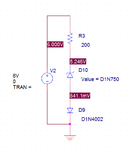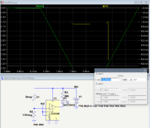JordanElektronika
Junior Member level 2
Good day! I have 2 circuits. The idea is to show a warning when the battery drops under 3.3V from 4.5V. Do you think they will work. One of them will turn off the diode when the voltage drops, the otherone will start the diode when the voltage drops. I am worried will the diode burn, because its connected directly to ground or because the current or voltage is too high.
On this schematic the diode turns off, when the current is too low to power it. The idea is when the current is 6mA the diode is active a little and almost impossible to see.

On this schematic when the zener can not hold 3.3V, the LED after it does not get activated. The current can not pass through the diode before the Voltage is 3.3V.

On this schematic the diode turns off, when the current is too low to power it. The idea is when the current is 6mA the diode is active a little and almost impossible to see.

On this schematic when the zener can not hold 3.3V, the LED after it does not get activated. The current can not pass through the diode before the Voltage is 3.3V.






